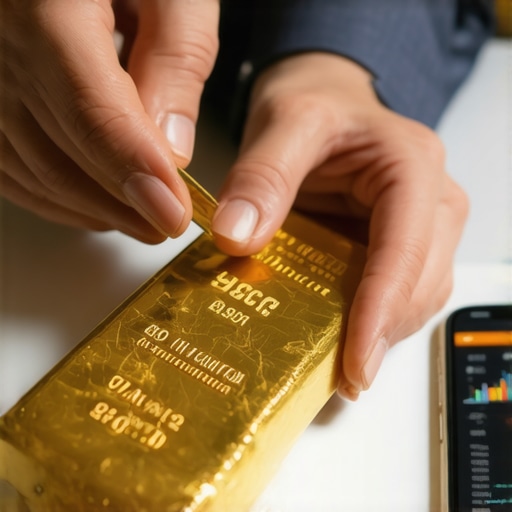Understanding Gold Investment for New Investors
As a new investor, navigating the world of gold can seem daunting. Gold has been a symbol of wealth and a reliable investment for centuries, making it a popular choice for diversifying portfolios. In this guide, we will explore essential insights into buying gold effectively, ensuring you make informed decisions in your investment journey.
Why Invest in Gold?
Gold is often considered a safe haven asset, especially in times of economic uncertainty. Investors flock to gold as a hedge against inflation and currency fluctuations. It not only retains value over time but can also provide liquidity, making it an attractive choice for those looking to safeguard their wealth.
Moreover, integrating gold into your investment strategy can lead to a well-rounded portfolio. It’s essential to understand the various forms of gold investments, including physical gold, gold ETFs, and gold stocks, to determine which option aligns with your investment goals.
Types of Gold Investments
When it comes to investing in gold, there are several avenues to consider:
- Physical Gold: This includes gold bars, coins, and bullion. Owning tangible gold allows you to hold your investment directly, providing a sense of security. However, consider storage and insurance costs.
- Gold ETFs: Exchange-traded funds offer a way to invest in gold without needing to buy and store physical gold. They track the price of gold and can be traded on stock exchanges, providing liquidity and ease of access.
- Gold Stocks: Investing in mining companies or gold-related businesses can provide exposure to gold prices without directly owning the metal. This option carries different risks and rewards compared to owning physical gold.
Key Considerations for New Investors
Before diving into the gold market, here are some critical factors to consider:
- Market Research: Understanding the dynamics of the gold market is vital. Factors such as supply and demand, geopolitical events, and economic indicators can all influence gold prices. Stay informed by reading articles and analyses, such as 2025 Gold Market Dynamics: Key Factors for Investors.
- Timing Your Purchase: Knowing when to buy gold can significantly impact your investment’s success. Look for trends in gold prices and consider the best time to make your purchase. For more insights, check out Determining the Best Time to Buy Gold: Insight for 2025.
- Diversification: While gold can be a great addition to your portfolio, it’s important not to put all your eggs in one basket. Diversifying your investments across different asset classes can mitigate risks.
By considering these factors and understanding the different types of gold investments available, new investors can make informed decisions that align with their financial goals. To explore further, discover Investing in Gold: A Comprehensive Guide for 2025, which provides deeper insights into the strategies for successful gold investment.
Strategies for Successful Gold Investment
As you delve deeper into the world of gold investing, it becomes crucial to develop effective strategies that align with your goals. Understanding how to navigate the gold market can significantly enhance your investment outcomes. Here are some strategies to consider:
Conducting Thorough Market Analysis
Market analysis is the cornerstone of successful investing. Keep an eye on gold price trends and historical data to identify potential patterns. Resources like Gold Market Analysis: Key Factors for Investors in 2025 can provide valuable insights. Understanding the factors influencing gold prices, such as central bank policies and global economic conditions, will give you a competitive edge.
Utilizing Tools for Price Forecasting
Investors should take advantage of various tools available for forecasting gold prices. These tools can help you anticipate market movements and make informed decisions. For instance, articles like A Comprehensive Guide to Gold Price Predictions for 2025 will help you understand how to analyze price predictions effectively.
Understanding the Role of Gold in Diversified Portfolios
Gold plays a vital role in a diversified investment portfolio. As a non-correlated asset, it can help reduce overall portfolio risk. Familiarize yourself with the concept of portfolio diversification by exploring The Role of Gold in a Diversified 2025 Investment Portfolio. This knowledge will allow you to balance your investments more effectively.
Best Practices for Buying Physical Gold
If you choose to invest in physical gold, there are essential practices to follow to ensure a successful purchase:
Choosing Reputable Dealers
Selecting a trustworthy dealer is paramount when buying physical gold. Research dealers in your area and check their reputations. Look for reviews and ratings to ensure you’re dealing with a reputable source. For tips on identifying quality gold dealers, refer to Tips for Identifying Quality Gold Dealers in Your Area.
Evaluating Gold Quality and Purity
Gold quality is measured in karats, with 24-karat gold being the purest form. When purchasing gold, ensure that you are receiving a product that meets your expectations for quality. Familiarize yourself with the differences between gold bars and coins, and consider reading Comparing Gold Bars vs. Gold Coins: Making Informed Choices for additional insights.
Understanding Storage and Insurance Options
Deciding how to store your physical gold is crucial. Consider the costs and logistics of secure storage solutions, such as safe deposit boxes or home safes. Additionally, explore the necessity of insuring your investment. For more details, check out Expert Tips for Physical Gold Investments: A 2025 Guide.
Exploring Alternative Gold Investments
In addition to physical gold, alternative investment vehicles like gold ETFs and mutual funds offer unique advantages. They provide exposure to gold prices without the need for physical ownership. Consider exploring Investing in Gold ETFs: Essential Insights for Newcomers to understand how these options can fit into your investment strategy. With the right knowledge and strategies, you can effectively navigate the gold market and make the most of your investments.
Exploring the Versatility of Gold ETFs for Investment Growth
Gold ETFs (Exchange-Traded Funds) have gained popularity among investors looking for an accessible way to invest in gold without the hassles of physical ownership. These funds are traded on stock exchanges and are designed to track the price of gold closely. By investing in gold ETFs, you gain exposure to gold prices while enjoying the liquidity typical of stocks.
One significant advantage of gold ETFs is their ease of trading. Unlike physical gold, which requires secure storage, gold ETFs can be bought and sold through a brokerage account. For those new to investing, understanding how gold ETFs function can be incredibly beneficial. To dive deeper into this subject, check out Investing in Gold ETFs: Essential Insights for Newcomers.
Gold Mutual Funds: A Managed Approach to Gold Investment
Gold mutual funds represent another alternative investment avenue, where funds are pooled together to invest in gold-related securities, including mining companies. This approach allows investors to benefit from professional management and diversification within the gold sector.
Investing in gold mutual funds can be ideal for those who prefer a hands-off approach. The fund managers handle the research and investment decisions, which can save time and reduce the burden on investors. To learn more about how mutual funds operate and their advantages, consider reading The Benefits of Investing in Gold Mutual Funds Explained.
Understanding Gold Futures and Their Potential
Gold futures offer a more advanced investment option, allowing investors to speculate on the future price of gold. In a futures contract, you agree to buy or sell a specific amount of gold at a predetermined price on a set date. This can lead to significant gains but also carries substantial risk.
For new investors, it’s crucial to grasp the complexities of futures trading. Understanding the market dynamics and the factors that affect gold prices, such as global economic conditions and geopolitical events, is essential for success. For a foundational overview, check out Understanding Gold Futures: Key Concepts for New Investors.
Risk Management in Gold Investments
Regardless of the type of gold investment you choose—be it physical gold, ETFs, mutual funds, or futures—implementing a sound risk management strategy is vital. Diversifying your gold investments across different types can help mitigate risks associated with market volatility.
Additionally, keep abreast of the factors influencing gold prices, such as inflation rates, interest rates, and currency fluctuations. By maintaining an informed perspective, you can make strategic decisions that align with your investment goals. For detailed strategies on risk management, refer to Key Strategies for Gold Investments for 2025.
Emerging Trends in Gold Investment for 2025
As the gold market continues to evolve, staying updated on emerging trends is crucial for investors. Current trends indicate a growing interest in gold as a hedge against inflation, especially in uncertain economic climates. Understanding these trends will enable investors to adapt their strategies and seize opportunities as they arise.
For those keen on understanding how to navigate the changing landscape of gold investments, resources like 2025 Gold Price Trends: Essential Predictions for Investors can provide valuable insights into market forecasts and expected shifts in investor behavior.
Exploring the Potential of Gold Futures in 2025
Gold futures are gaining traction among investors aiming to leverage price speculation in the gold market. These contracts allow you to agree upon a future price for gold, providing opportunities for profit in fluctuating markets. However, trading in futures requires a comprehensive understanding of the underlying market forces driving gold prices.
For new investors, grasping the basics of futures trading is crucial. It’s advisable to explore resources like Understanding Gold Futures: Key Concepts for New Investors, which breaks down essential concepts and market dynamics. By familiarizing yourself with futures contracts, you can make informed decisions that align with your investment strategy.
Risk Management Strategies for Gold Futures
Effective risk management strategies are paramount when trading gold futures. This includes setting stop-loss orders to protect against significant losses and diversifying your investment portfolio across various asset classes, including physical gold and ETFs. Understanding how external factors such as inflation and geopolitical tensions impact gold prices will allow you to make more calculated trading decisions.
For additional insights into managing your investments effectively, consider reading Key Strategies for Gold Investments for 2025, which offers comprehensive tips to safeguard your portfolio.
Gold Demand Trends and Their Impact on Investment Strategies
The demand for gold can significantly influence market prices and investment strategies. Factors such as economic uncertainty, inflation concerns, and increased consumer interest in gold jewelry can drive demand. As an investor, staying informed about these trends can help you adjust your strategy accordingly.
For a deeper understanding of how these demand trends shape the market, check out Decoding Gold Demand Trends: What Investors Must Know. This resource provides valuable insights into the factors influencing gold demand and how they can affect your investment decisions.
The Role of Central Banks in Gold Demand
Central banks play a significant role in the global gold market, often purchasing gold as part of their reserves. Their buying actions can impact gold prices dramatically, making it essential for investors to monitor central bank activities. Understanding the implications of these purchases can position you to make strategic decisions that align with broader market trends.
To explore how central bank policies influence gold prices, consider reading Understanding How Central Bank Gold Purchases Affect Prices. This article provides critical insights into the relationship between central bank actions and gold market dynamics.
Maximizing Returns with Gold ETFs
Gold ETFs (Exchange-Traded Funds) remain a popular choice for investors seeking exposure to gold without the complexities of physical ownership. These funds offer liquidity and ease of trading, making them an attractive option for both new and experienced investors.
Investing in gold ETFs allows you to benefit from price movements without the need for secure storage. For those interested in maximizing their investments through ETFs, resources like Maximize Your Returns with Gold Exchange-Traded Funds provide valuable strategies to enhance your investment outcomes.
Long-Term vs. Short-Term Gold Investment Strategies
When considering gold as part of your portfolio, it’s essential to determine whether you are looking for long-term stability or short-term gains. Long-term investors may focus on the fundamental value of gold as a hedge against inflation, while short-term traders might capitalize on market volatility.
Before making any investment decisions, evaluate your goals and market conditions. For further guidance on this topic, refer to The Future of Gold Prices: Key Trends to Watch in 2025, which discusses potential market shifts and investment strategies for varying timelines.
Frequently Asked Questions About Gold Investment
What is the best way for new investors to start investing in gold?
For new investors, starting with gold ETFs or mutual funds is often recommended. These options provide exposure to gold prices without the complexities of owning physical gold. Additionally, researching reputable dealers if opting for physical gold is essential.
How do gold prices fluctuate?
Gold prices fluctuate due to various factors, including economic indicators, inflation rates, geopolitical events, and central bank policies. Keeping informed about these elements can help investors anticipate market movements.
Is investing in physical gold safe?
Investing in physical gold can be safe if you follow best practices, such as purchasing from reputable dealers and securing your investment with insurance and proper storage solutions.
What are gold ETFs and how do they work?
Gold ETFs are investment funds that track the price of gold. They are traded on stock exchanges like stocks, providing investors with liquidity and ease of access to gold price movements without owning the physical metal.
Can gold be a good hedge against inflation?
Yes, gold is often viewed as a hedge against inflation. Its value tends to rise when inflation increases, making it a popular choice for investors looking to protect their purchasing power.
What are the risks associated with gold futures trading?
Gold futures trading carries risks such as market volatility, leverage risks, and the potential for significant losses. It’s crucial for investors to understand these risks and implement effective risk management strategies.
How do I determine the right time to buy gold?
Timing your gold purchases involves analyzing market trends, historical data, and economic conditions. Staying informed through reliable resources can help you make strategic buying decisions.
What role do central banks play in the gold market?
Central banks influence the gold market through their buying and selling actions. Their purchases can affect gold prices significantly, making it essential for investors to monitor central bank activities to inform their investment strategies.
Are gold mutual funds a good investment option?
Gold mutual funds can be a good option for investors seeking professional management and diversification within the gold sector. They allow investors to participate in gold-related securities without needing to manage individual stock holdings.
How can I maximize my returns from gold investments?
To maximize returns from gold investments, consider diversifying your portfolio, staying updated on market trends, and utilizing both short-term and long-term strategies based on your financial goals.
Authority Resources for Gold Investment
For further insights and reliable information on gold investments, consider exploring the following authority resources:
- World Gold Council – A leading authority on gold, providing research, market insights, and reports.
- Investopedia – Offers comprehensive articles and tutorials on gold investing and market analysis.
- Kitco News – Provides timely updates on gold prices, market news, and expert analysis.
- Bloomberg Markets – A trusted source for financial news, including gold market trends and investment strategies.
- Trading Economics – Offers economic indicators and forecasts that impact gold prices.
Conclusion: Your Path to Successful Gold Investment
Investing in gold presents an array of opportunities and challenges. Whether you choose physical gold, ETFs, or mutual funds, understanding the market dynamics, risk management strategies, and emerging trends is vital for success. By leveraging the insights from this comprehensive guide and utilizing the authority resources provided, you can navigate the gold investment landscape with confidence and make informed decisions that align with your financial goals. Remember, gold remains a valuable asset for diversification and wealth preservation in uncertain economic times.









